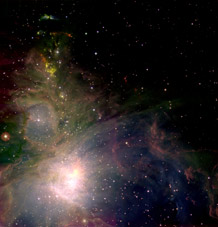
Orion Nebula - 1270 light-years
The Orion Nebula is situated south of the of three stars in the constellation bearing the same name. This is one of the brightest nebulae (a huge cloud of gas and dust) and is visible to the naked eye on clear, dark nights. This infrared image shows young stars forming and the heated gas filaments surrounding them. It was taken using the United Kingdom Infrared Telescope on Mauna Kea in Hawai.
Credits: Chris J. Davis, Joint Astronomy Centre.
Local people invited to join a journey through the Galaxy
Local people are invited to join University of Exeter astronomers for a journey through the Galaxy.
The Astronomy Open Evening on Tuesday 4 May 2010 will include demonstrations and hands-on activities for people of all ages, as well as talks on the latest astronomy research and a spectacular exhibition of images: From Earth to the Universe.
Visitors will also have the opportunity to use high-quality telescopes and to join University astronomers for an observation of the night sky, weather permitting. Inside, they will also have the chance to view the world in the infrared, experience planetary exploration with the helium blimp, and explore the fantastic world of supercomputer simulations. Every half hour, there will be talks by Astrophysics group scientists on how stars and planets form.
The event is the second of its kind and follows on from the success of the 2009 Astronomy Open Evening, which saw 250 people flock to the University to celebrate the International Year of Astronomy.
Dr Jennifer Hatchell of the University of Exeter’s Astrophysics Group said: “We are really looking forward to welcoming people of all ages to the University to share our passion for astronomy. From hands-on activities for very young children to talks on the latest research and discoveries, the evening will have something to get everyone excited about the wonders of the universe.”
The University of Exeter has one of the UK’s largest astrophysics groups working in the fields of star formation and exoplanet research. The group focuses on one of the most fundamental problems in modern astronomy – when do stars and planets form and how does it happen? They conduct observations with the world’s leading telescopes and carry out numerical simulations to study young stars, their planet-forming discs, and exoplanets. This research helps to put our Sun and the solar system into context and understand the variety of stars and planetary systems that exist in our Galaxy. Over the next three years, the University is investing £80 million in five areas of interdisciplinary scientific research, one of which is Extrasolar Planets.
The Astronomy Open Evening is on Tuesday 4 May and starts at 7pm in the Peter Chalk Centre, University of Exeter, Streatham Campus and is free of charnge, no booking required.
Date: 30 April 2010
